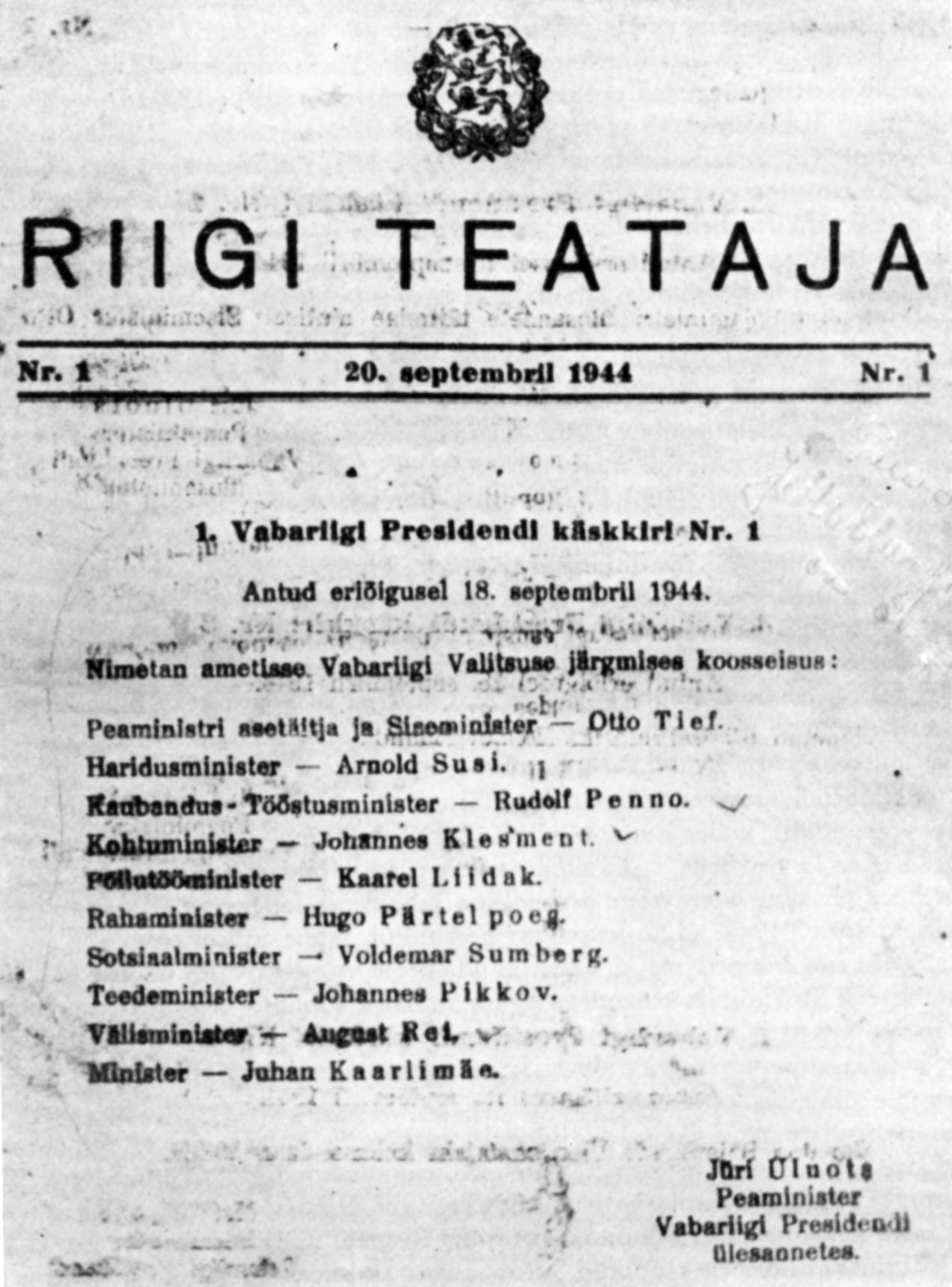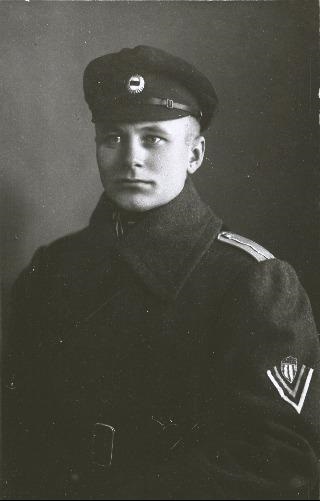|
Estonian Anti-German Resistance Movement 1941–1944
The Estonian resistance movement (Estonian ''Eesti vastupanuliikumine'') was an underground movement to resist the occupation of Estonia by Nazi Germany, 1941–1944 during World War II. Due to the unusually benign measures implemented in Estonia by the German occupation authorities, especially in contrast to the preceding harsh Soviet occupation of Estonia (1940–1941), the movement was slower to develop effective tactics on a wide scale than in other occupied countries. Background While there was a general mood of gratitude towards Germany as the liberator of Estonia from Soviet occupation, this reservoir of goodwill dissipated within the first months of the war and was transformed into a mood ranging from resigned indifference to active hostility. Former Prime Minister Jüri Uluots' request to the German occupation authorities for the establishment of an independent Estonian Government was rejected and Adolf Hitler subsequently appointed Alfred Rosenberg as Reich ... [...More Info...] [...Related Items...] OR: [Wikipedia] [Google] [Baidu] |
Occupation Of Estonia By The German Empire
Estonia was under military occupation by the German Empire during the later stages of the First World War. On 11–21 October 1917, the Imperial German Army occupied the West Estonian archipelago (Moonsund archipelago), including the larger islands of Saaremaa (''Ösel''), Hiiumaa (''Dagö''), and Muhu (''Moon''). Fighting in Estonia ceased whilst negotiations over the Treaty of Brest-Litovsk took place. These broke down in February 1918, and to put pressure on the new Bolshevik regime of Soviet Russia to sign the Treaty of Brest-Litovsk, the Germans landed on the mainland of Estonia on 18 February 1918 and marched on Haapsalu (''Hapsal'') on 21 February 1918. The German forces occupied Valga (''Walk'') on 22 February, and Pärnu (''Pernau''), Viljandi (''Fellin'') and Tartu (''Dorpat'') on 24 February. Tallinn (''Reval'') was occupied on 25 February 1918, and in the rest of the Estonian mainland the last town captured by German forces was Narva (''Narwa'') on 4 March 1918. For t ... [...More Info...] [...Related Items...] OR: [Wikipedia] [Google] [Baidu] |
Finnish Infantry Regiment 200
Infantry Regiment 200 (, ) or soomepoisid (''Finnish Boys'') was a unit in the Finnish army during World War II made up mostly of Estonian volunteers, who preferred to fight against the Soviet Union in the ranks of the Finnish army instead of the armed forces of Germany. Background In September 1939, the Soviet Union entered World War II by first invading Poland from the east and then ''de facto'' occupying the Baltic states. In August 1940, the Republic of Estonia was officially annexed by the Soviet Union. During the following year, thousands of Estonians were arrested, executed, or sent to the Soviet concentration camp system in Russia. After war broke out between the Soviet Union and Germany on June 22, 1941, the Soviet authorities in occupied Estonia, in violation of the international law, coerced about 30,000 Estonians into service in the retreating Red Army. Although initially the Germans were perceived as liberators by most Estonians, it was soon realized that they ... [...More Info...] [...Related Items...] OR: [Wikipedia] [Google] [Baidu] |
Pikk Hermann
Pikk Hermann (Estonian ; ) is a tower of the Toompea Castle, on Toompea (Domberg) hill in Tallinn (Reval), the capital of Estonia. The first part of the tower was built in 1360–1370. It was rebuilt (height brought to ) in the 16th century. A staircase with 215 steps now leads to the top of the tower. It consists of ten internal floors and a viewing platform at the top. Pikk Hermann is situated next to the building of the Estonian parliament (''Riigikogu''). The flag on the top of the tower at above sea level is one of the main symbols of the national government in force. The national flag, a blue-black-white tricolour measuring by , is raised and the national anthem A national anthem is a patriotic musical composition symbolizing and evoking eulogies of the history and traditions of a country or nation. The majority of national anthems are marches or hymns in style. American, Central Asian, and European ... is played at the time of sunrise (or at 7 am, whichever ... [...More Info...] [...Related Items...] OR: [Wikipedia] [Google] [Baidu] |
Flag Of Estonia
The national flag of Estonia () is a tricolour (flag), tricolour featuring three equal horizontal triband (flag), bands of blue at the top, black in the centre, and white at the bottom. The flag is called () in Estonian. The tricolour was already in wide use as the symbol of the nation, when the Republic of Estonia became an Estonian Declaration of Independence, independent country in 1918. Formally, the tricolour became the national flag by the decision of the Estonian Provisional Government, Estonian government on 21 November 1918, and the Riigikogu, parliament later reconfirmed the flag's official status with a law in 1922. During World War II, soon after the Soviet Union, Soviet army had invaded and occupied Estonia in June 1940, the new Stalinist occupation regime banned the Estonian flag, and its use as well as any use of its blue, black and white colour combination became punishable by laws of the Soviet Union. The Estonian flag was from 1940 until 1991 continuously used ... [...More Info...] [...Related Items...] OR: [Wikipedia] [Google] [Baidu] |
Toompea
Toompea (from , "Cathedral Hill") is a hill in the central part of Tallinn, the capital city of Estonia. The hill has an area of and is about 20–30 metres higher than the surrounding areas. Toompea is part of the medieval Tallinn Old Town, a UNESCO World Heritage Site. Toompea is the site of the Government of Estonia and the ''Riigikogu'' (parliament), both of which are often simply referred to as ''Toompea''. The parliament meets in the Toompea Castle which is situated in the southwestern corner of the hill and topped by the Pikk Hermann ("Tall Hermann") tower. The flag on the top of the tower is one of the best-known symbols in Estonia of the government in force. Toompea first emerged as an island from the Baltic Ice Lake around 10,000 years ago. Due to steady post-glacial rebound it became connected with the mainland during the early Littorina Sea stage. At 5,000 BCE the sea still reached the foot of the cliffs of Toompea. The modern coastline is at a distance of more tha ... [...More Info...] [...Related Items...] OR: [Wikipedia] [Google] [Baidu] |
Otto Tief
Otto Tief ( – 5 March 1976) was an Estonian politician, military commander, and a lawyer. Tief was the acting prime minister of the last government of EstoniaThe Otto Tief government and the fall of Tallinn 22 September 1944: From one occupation to another before Soviet troops occupied in the Second Wo ... [...More Info...] [...Related Items...] OR: [Wikipedia] [Google] [Baidu] |
National Committee Of The Republic Of Estonia
The National Committee of the Republic of Estonia (, EVRK) was a deliberative and legislative body, formed by Estonian politicians and members of the last government of Republic of Estonia before the Soviet occupation, to control the Anti-Soviet resistance movement in Nazi-occupied Estonia in March 1944. By April 1944 a large number of the committee members were arrested by the German security agencies. On September 20, 1944, the committee proclaimed the Republic of Estonia restored, but two days later, the Soviet Army took control of Tallinn. History The original initiative to form the committee came from the Estonian former pre-plebiscite of 1933 opposition parties and it denied the constitutional authority of Jüri Uluots, the last pre-war Prime Minister of the Republic of Estonia. On July 29, 1941, Uluots met with the Nazi military government of Tartu, thanked them for freeing Estonia and asked them to allow him to form the government of independent Estonia with its owned a ... [...More Info...] [...Related Items...] OR: [Wikipedia] [Google] [Baidu] |
Nordic Journal Of International Law
''Nordic Journal of International Law'' () is peer-reviewed journal published by Brill Nijhoff. It focuses on topic related to Nordic countries The Nordic countries (also known as the Nordics or ''Norden''; ) are a geographical and cultural region in Northern Europe, as well as the Arctic Ocean, Arctic and Atlantic Ocean, North Atlantic oceans. It includes the sovereign states of Denm ... and its legal topics. First number issued in 1930. See also * Retfærd References International law journals Academic journals established in 1930 Nordic countries {{law-journal-stub ... [...More Info...] [...Related Items...] OR: [Wikipedia] [Google] [Baidu] |
Republic Of Estonia
Estonia, officially the Republic of Estonia, is a country in Northern Europe. It is bordered to the north by the Gulf of Finland across from Finland, to the west by the Baltic Sea across from Sweden, to the south by Latvia, and to the east by Russia. The territory of Estonia consists of the mainland, the larger islands of Saaremaa and Hiiumaa, and over 2,300 other islands and islets on the east coast of the Baltic Sea. Its capital Tallinn and Tartu are the two largest List of cities and towns in Estonia, urban areas. The Estonian language is the official language and the first language of the Estonians, majority of its population of nearly 1.4 million. Estonia is one of the least populous members of the European Union and NATO. Present-day Estonia has been inhabited since at least 9,000 BC. The Ancient Estonia#Early Middle Ages, medieval indigenous population of Estonia was one of the last pagan civilisations in Europe to adopt Christianity following the Northern Crusades in the ... [...More Info...] [...Related Items...] OR: [Wikipedia] [Google] [Baidu] |
Ernst Kull
Ernst is both a surname and a given name, the German, Dutch, and Scandinavian form of Ernest. Notable people with the name include: Surname * Adolf Ernst (1832–1899) German botanist known by the author abbreviation "Ernst" * Anton Ernst (born 1975), South African film producer * Alice Henson Ernst (1880-1980), American writer and historian * Bastian Ernst (born 1987), German politician * Britta Ernst (born 1961), German politician * Cornelia Ernst (born 1956), German politician * Edzard Ernst (born 1948), German-British academic * Emil Ernst (1889–1942), astronomer * Ernie Ernst (1924/25–2013), American judge * Eugen Ernst (1864–1954), German politician * Fabian Ernst (born 1979), German soccer player * Fedir Ernst (1891-1942), Ukrainian art historian * Gustav Ernst (born 1944), Austrian writer * Heinrich Wilhelm Ernst (1812–1865), Moravian violinist and composer * Jim Ernst (born 1942), Canadian politician * Jimmy Ernst (1920–1984), American painter, son of Ma ... [...More Info...] [...Related Items...] OR: [Wikipedia] [Google] [Baidu] |





